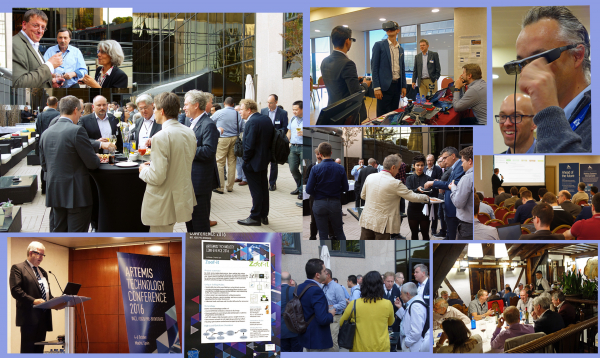- Published on 14 Nov 2016
- Events
ARTEMIS Technology Conference 2016
The combination of the ARTEMIS Technology Conference (ATC) with a Pre-Brokerage was initiated for the first time in Turin last year. However, as some of you may remember, ARTEMIS-IA members have organised Technology Conferences already since 2010, with a first edition in beautiful Budapest organised by the project partners of SCALOPES, INDEXYS, CESAR, SYSMODEL and hosted by AITIA & BME. This tradition of presenting the technological results of the ARTEMIS projects continued each year in different forms and were organized by other projects. Starting with the ATC in 2015, the programme was enriched with extra keynote speakers, full-day workshops and a Pre-Brokerage element. The increase of programme parts also resulted in an increase of participants. This year the 3-day Conference was visited by 160 guests, of which most are ARTEMIS-IA member, but we also welcomed 14% non-member companies and research organisations.
Project Workshops
In line with presenting project results with a focus on technological achievements, at ATC 2016 the projects Arrowhead, EMC2, R5COP, ACCUS, and CP-SETIS organised a half or full-day workshop. The Arrowhead project presentation highlighted several subject, among which ‘’Plant automation systems in the cloud” and “protocol translation”, followed in the afternoon by several Demo deployments, such as “Arrowhead plant automation”. On the same morning, CP-SETIS presented its structure and status of the Interoperability specification IOS, building on results from previous ARTEMIS projects, highlighting the “CRYSTAL Automotive Use Case’’ and showing the options and benefits of setting up an IOS Cooperation Forum. After an enjoyable lunch, the vision behind ACCUS (Adaptive Cooperative Control in Urban (sub) Systems) was presented by six project partners, with Energy management as one of the subjects presented. On the second day, both EMC2 and R5COP presented their project results and demonstrator models. Application Innovation by EMC2 is based on improved performance, lower cost and higher energy efficiency of multi-core applications. Very interesting were the EMC2 – Arrowhead project synergies presented by the WP1 with subject SoA System Architectures. Various robot interaction, based on ‘’Advanced and experimental human-machine interfaces’’ and ‘’ Augmented Reality”, was demonstrated by R5COP partners PIAP, BME and Probot in the afternoon.
Project Tracks
In parallel to the Workshops, ATC 2016 featured shorter project tracks over the course of two days. The themes of these 30 minutes presentations were this year; Smart Cities, Smart Energy, Manufacturing, Mobility and Future CPS. Each presentation provided information about their technological challenge, their solutions and application examples of technology used. The overview of the project, coming from different funding-programmes, provided a very interesting insight in the joint challenges and the different solutions, and led to an engaged audience and lively discussions.
Keynote speakers
Focusing on Cyber Physical Systems - the “Embedded Intelligent ICT 1 Systems” - Werner Steinhoegl provided insight into the EC Strategy for Digitising European Industry. The information contained a clear overview of programmes related to Cyber-Physical Systems in Europe. As part of these programmes, Bert de Colvenaer continued with the explanation of ECSEL and its calls for projects, to provide a basis to prepare for the upcoming ECSEL 2017 calls. In addition to the call information, Prof. Dr. Dieter Rombach of Fraunhofer gave a very strong keynote with clear examples of Digitalization as Driver for new Business models that change industry. Throughout his inspiring talk it became very clear that Industry 4.0 is much more than just automation; we actually need to invent new business models and services that adapt and optimize benefits for the end-users.
Preparation for the next calls
In line with several open H2020-ICT 2016 calls and in preview of other future H2020 call, this year’s H2020 Pre-Brokerage provided the opportunity to prepare for the upcoming CPS relevant calls, such as H2020 ICT, IoT and ECSEL calls. Prior to the Conference, project proposers used the ARTEMIS Project Idea Tool (PIT) to create awareness for their project idea and search for partner. Furthermore, pitches and posters were presented to stimulate conversations. To optimize networking moments, this year’s conference provided two evening programmes to enjoy in a relaxed and inspiring atmosphere. The network reception, in summer-time ambiance, was the perfect setting to connect with many different future project partners. The in-depth conversations continued the next day in a setting of an authentic Spanish Inn established in 1642 in the city center of Madrid.
With valuable feedback from the event-questionnaire, we will certainly optimize the next edition of the ARTEMIS Technology Conference. See you then!



